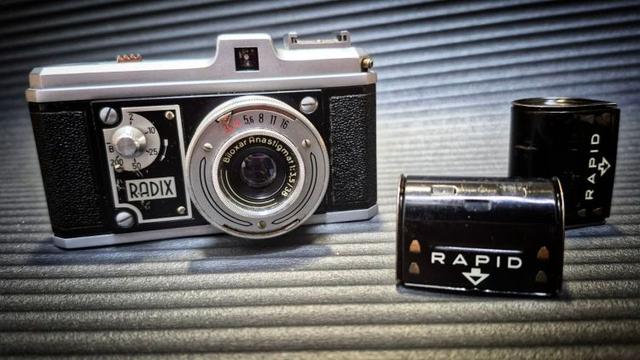A Karat Film Camera That Wasn’t Made By Agfa: The Bilora Radix 35 BH
I came across an odd one the other day. I was searching for some history on the Karat film system, the original version of Agfa’s Rapid system launched (or relaunched) in the 1960s, and naturally Chrome suggested an article by Mike Eckman. Keppler’s Vault 84: AGFA Rapid Film, is a thorough history of the Rapid film system. It delves into the history of the format, notably that the Rapid film system was based on a revival of Agfa’s Karat film from the 1930s and 40s. (Interestingly, Karat film was an attempt to compete with Kodak’s 35mm cassette.)
In the post, Mike Eckman discusses the history of the Rapid film system with reference to a couple of contemporary articles from the 1960s. ‘The second article’, Eckman writes, ‘is from August 1964, and … tells some of the history of the format, even alluding to a very rare Bilora Radix Karat camera that was introduced in 1949 ….’ Mentally, my ears pricked up. What? A Karat camera not made by Agfa? Of course, my curiosity was raised so I started a search for this elusive ‘Bilora Radix camera’.
Turns out that there is quite a bit of information out there about the Radix. It was only around for a few years, from 1948 until about 1952, and it was bad timing by the Bilora camera company, better known for its cheap box cameras, to launch a Karat format camera just as Agfa was winding down its own operations in favour of using the dominant 35mm film cassette. There were a whole range of Radix cameras, from models with a fixed shutter speed, but a variable aperture, to models with five shutter speeds.
Well, by now I really wanted to get my hands on one of these cameras, so turned my attention to that popular auction site. There were a few variations available in Europe, and prices were not that bad. I found one interesting item in Germany. ‘For sale is an old camera that shoots in the 135mm square format using 24×24 film’, the advert for the item said (in German). ‘I found it in a store, bought it home, and used it to shoot two rolls of FomaPAN200.’ Unusually for an eBay post, this advert actually included two or three images taken with the camera, and they weren’t bad.
‘Although this camera isn’t famous,’ the description continued, ‘it’s still an improved version of the RADIX series with adjustable shutter speeds. The lens is clear and scratch- and fungus-free, and the shutter is precise and stick-free.’ According to the description and photographs the camera even included two Rapid canisters, so now I was really interested. Fortunately, I won the auction, although someone did try to snap it up at the last second, but didn’t bid higher than my max bid, and the auction closed.
The Bilora Radix is a strange beast. Yes, it looks like a normal camera, but the shutter button is not a button but a serrated lever that slides left to right. The shutter speed dial is a knob on the front of the camera to the right of the lens, and the back is removed by twisting the two lugs on the back of the camera which comes off in one piece. The aperture is changed by a small lever on the front of the lens, and this model was known as the Radix 35 because it is fited with an f3.5 lens. Another model, fitted with an f5.6 lens is known as the Radix 56. I think this version is one of the later models in the Radix range, and I reckon that it dates from the early 1950s. All in all, it’s in pretty good condition for a 70-year-old camera.
This version of the Radix is quite sophisticated compared to others in the Range, with variable shutter speeds and apertures. It also came with two Rapid canisters, which was really useful. The take-up canister is nice and lose in its space, but the full/delivery canister was really tight. I’m wondering if this is because of a difference between Rapid and Karat canisters, and I’m going to have to compare these later, but it doesn’t seem to make any difference to the function of the camera.
In the meantime, I’m going to load the Radix with a roll of Harman Phoenix redscaled film that I have loaded in a canister and take that to Aveiro. One thing I did find about the Radix is that when you open the back it doesn’t reset to 0, the numbers just continually cycle around. I wound the camera back to the dot after ’16’ and loaded the canister of Phoenix. I fired off two frames, but instead of a ‘1’ appearing for the start of the film, an ‘A’ appeared, followed by a dot. In fact, it looks like these frame indicator goes, ‘1 … 16 . . . A . 1 …’. But hopefully it’ll work OK.
As the film was redscaled I rated it at ISO 100, and set the shutter speed to 1/200s, the fastest shutter speed of the Radix. To judge the correct exposure, I used the Camera Meter app. It was a cloudy day, and around Aveiro the suggested aperture for the redscaled Harman Phoenix film was mainly between f16 and f8.
Aside from a couple of images in Oiã, I only managed about 6 exposures in total from what turned out to be a really short piece of film, and only one was from Aveiro. There were a few light leaks, and I’m still not sure where these were from, but I was delighted with the images that turned out and I can’t wait to get out with the Bilora Radix again soon. I’ve posted the whole roll in an album on my Flickr, light leaks and all, if you want to see the rest of the images.
https://flic.kr/p/2r2ZtEh
https://flic.kr/p/2r35RHH
https://flic.kr/p/2r36fZX
If you are on Mastodon, you can now follow this blog directly. Just go to Mastodon and follow the ‘Snapshot’ WordPress account at @keithdevereux.wordpress.com. All new posts will be automatically updated to your timeline.
#Agfa #AgfaKarat #AgfaRapid #Bilora #BiloraRadix #Canister #Experimental #Karat #Rapid #RapidFilm #Vintage #Radix




